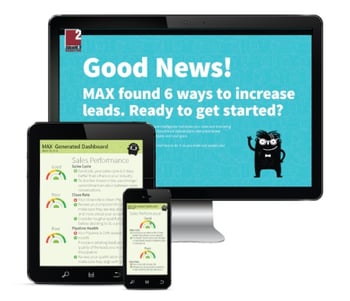
How AI Is Reshaping What You Expect From Your Digital Marketing Agency
Too Much Data Exists For Humans To Efficiently Provide The Guidance You Need
 We’re a long way from Skynet taking over the world, and we’re a long way from having software eliminate the need for human beings to be part of the marketing, sales and servicing improvement conversation.
We’re a long way from Skynet taking over the world, and we’re a long way from having software eliminate the need for human beings to be part of the marketing, sales and servicing improvement conversation.
But the added complexity associated with the buyer journey and how marketing, sales and customer service teams evaluate performance, gain insights and drive improvements is starting to demand additional tools that make this a perfect application for artificial intelligence (AI) and machine learning.
Today, the people responsible for driving revenue growth (the revenue team, which is made up of marketing, sales and customer service leaders) are overwhelmed with data, overwhelmed with the ability to create custom dashboards to monitor that data and overwhelmed by the sheer number of actions that could be taken to improve results.
What do we do first? What will have the biggest potential improvement? How do we prioritize? How do we gain insights from the analytics? What should our action plan be today, tomorrow and next month?
This is one of the biggest challenges facing everyone responsible for delivering an amazing customer experience that drives revenue and company growth.
But before we dig into the AI options available, let’s look at what’s making the execution of marketing, sales and customer service so complicated.
Your Prospects Are Expecting An Amazon Experience
As consumers, we’re all getting spoiled by Amazon, Netflix, Zappos and other business-to-consumer (B2C) businesses that are delivering an amazing customer experience.
Just consider your last Amazon experience. You logged in, they know you, they know what you bought, they know what you looked at and they’re serving it all up to you to make your shopping experience remarkable. Plus, they’ll even deliver it to you the same day or the next day.
This is what we’re all starting to expect in our business-to-business (B2B) buyer journey, too. We want websites to recognize us, know what we’ve downloaded and serve up new related content. We expect the sites to be ready to answer our every question at a moment’s notice and with no delay.
We expect to be advised, counseled and guided (not sold to), and we expect it to be fun. This is great when we’re buying sneakers or laundry detergent, but what about software, manufacturing services, professional services and chemicals. How do you deliver a similar experience?
Prospects Have Access To More Content Than Ever Before
This is how marketers and progressive sales teams have responded to the question above. You’ve inundated your prospects with content in an attempt to give them the educational experience they’re asking for.
But in that effort, you’ve overwhelmed them and made their decisions much more complicated, because not only are you providing content, but all of your competitors and potential competitors are also providing content. Content is also being distributed to all of their friends, family, peers, colleagues and leaders within their own company.
Content itself has exploded with video, podcasts, blog articles, live events, chat and interactive assessments also crowding your prospects’ inboxes.
Accenture suggests that your average prospect is bombarded with over 3,000 messages a day. This includes emails, banner ads, social touches and shared links.
This isn’t helping. In fact, it’s making it more difficult for prospects to make head or tails of your content, and they don’t know what content is high quality and what is low quality. It’s hard to differentiate between useful and useless content.
More Data Than Ever Before Is Available
Not only is content overwhelming everyone, but data is also spilling out everywhere. With so much data, how can anyone know what to do with it or where to get it? How can people be sure which view of the data is right?
Now you can create a dashboard with any data from any system. But what good is that if you don’t know how to read the dashboards, respond to the trend data and execute the tactics that either fuel growth or reverse the negative trends?
On the surface, this might make it sound like it’s easier to drive results, but in reality, this is making it harder and more complex. Having more dashboards doesn’t necessarily lead to better results. Yes, it’s great to know data is trending down, but if you can’t correct it, what good is it?
More Tactics For Execution Exist Than Ever Before
It’s not like the old days, when you’d place an ad in a magazine and pray, or attend a trade show and hope enough people would come by to make the ROI work out.
Today, you can execute more than 50 marketing tactics alone, and then you also have crossover tactics that impact marketing and sales. That’s not even including applying some similar campaign tactics like chat, which drives conversions and sales-ready leads at the same time.
In most cases, your marketing team simply can’t do everything at once. Now you have to prioritize which tactics are must-haves and which ones are nice-to-haves. Then, with the must-haves, you need to decide which ones should get done first.
It’s still confusing, and unless you’ve had the benefit of executing 50 or 60 active engagements with all of these tactics, technology and data, you’re going to be flying by the seat of your pants.
More Software Tools To Help With Execution Exist Than Ever Before
Due to all of this complexity, more than 7,000 marketing and sales-related software products are on the market today, and more are coming out every day.
It’s a huge market to provide companies like yours with software in an attempt to make what we’re describing above much easier to manage, analyze, plan for and execute.
But now your job has become even more complicated. Consider these questions:
- Which software do you buy?
- How do you integrate it with the rest of your tech stack?
- How do you evaluate new products?
- How do you operationalize those products?
Your goal is not to buy the software; your goal is to use the software to produce results. The factors listed above have made it almost impossible to manage the execution of marketing tactics, sales playbooks and customer service delivery. It’s why tools like HubSpot have started to stretch outside of traditional marketing and into sales and service.
As human beings, we need help automating repetitive tasks, providing consistency around communication, and getting analytics into what’s working and what’s not.
But this isn’t enough. The $100,000 question still remains: What do we do?
What do we do first? What will produce the biggest lift? How do we prioritize? How do we gain insights from the analytics? What should our action plan be today, tomorrow and next month?
This all brings us to the slew of new AI and machine learning tools that are making their way into the market. These should be designed to answer that question, but are the current tools answering the right questions?
For years, teams, agencies and even some of the software products have been built around the legacy silos that were created when marketing was much simpler.
You have your paid media team (or agency). You have your website team (or agency). You have your email team (or agency). You get the idea. In some cases, you might even have a person (or a team) who is a general practitioner and responsible for all of this stuff, or you may have an agency that brings expertise in each of these areas, so you don’t have to worry about hiring all of that talent.
This is exactly how my marketing team at the software company I used to work at prior to Square 2 Marketing looked like, and it’s how I ran the teams there. It worked great, but it would not work so well today.
This legacy thinking is still influencing the way AI software is built today. You’ll find AI to make email marketing better, AI to make social media marketing better, AI to make conversion optimization better and AI to make content marketing better. They’re all individual tools with individual tactical improvement objectives. If you’re looking for a clearing house for all of these solutions, consider checking out the Marketing Artificial Intelligence Institute.
Even with all of this information and all of these software options, how does it answer our ultimate question from above: What do I do? Why can’t these AI tools answer that question?
Maybe They Don’t Know What To Do
Looking holistically across your entire revenue spectrum and drilling down into marketing, sales and customer service in a quest to generate consistent, scalable and predictable revenue is no easy task.
It’s not surprising that most of the AI software tools didn’t tackle this big challenge. Instead, they tried to cover what areas they already had some experience in. By focusing on single slices of the revenue challenge, they could get a social media, paid media, content marketing or email marketing product to market faster — so that’s what they did.
But when it comes to looking at everything you can do to drive revenue, they fall short.
Who Does Know What To Do?
It begs the next question: If all of those software companies don’t know what to do, when to do it and how to do it, then who does?
To answer that question, you have to look for the collection of experiences around gaining conversions, getting clicks, generating leads, closing sales opportunities and growing revenue. You find those experiences at agencies.
In particular, agencies that have been doing this for long enough to have seen it all. They’ve seen high-performing programs, moderately-performing programs and underperforming programs. They’ve seen clients who took their advice and clients who did not. They’ve seen tactics work in one industry and not in another. They’ve seen it all and they know how to respond to it all.
That experience is generally what we think is missing, and it’s why some companies see growth and others don’t. Without experienced navigators, guides and advisors helping you work through the complexity we described above, it’s going to take longer and cost more to get to your revenue goals (if you reach them at all).
Turning That Knowledge And Experience Into An AI Tool
If all of that experience is valuable and everyone is working so hard to execute revenue generation programs, then why aren’t agencies creating their own software tool to share those experiences?
At Square 2 Marketing, we are. We’re introducing MAXG. It stands for Marketing Advisor for eXponential Growth, but we fondly refer to him as MAX.

MAX takes your sales and marketing data, marries it with industry-specific benchmark data and aligns it with your stated business goals.
MAX produces prescriptive program recommendations that are based on thousands of experiences using a variety of sales and marketing tactics to drive revenue.
MAX is a proprietary revenue recommendation engine that uses data-driven intelligence to help you know what to do, when to do it and how to drive revenue for your company.
MAX knows your business and revenue goals, your current sales, marketing and customer service-related challenges, your industry, and your actual performance data from Google and HubSpot (to start).
Then, MAX provides you a list of recommendations with a prioritization system for organizing the action items, and keeps tabs on your progress. As items come off of the list, MAX recommends new action items that drive you to your goals.
MAX also learns. As your program produces results, MAX learns what works and what doesn’t work as well. MAX also learns from other customers’ programs, taking that learning into account as he provides recommendations over time. In essence, the more people who use MAX, the smarter and the better the recommendations get over time.
Right now, our team is using MAX. We’re teaching MAX everything we know and testing MAX out on our clients. But in just a few weeks, MAX is going to be available to the general public.
If you’re interested in a sneak peek at MAX, just click the button below and visit the page on our website. We’re happy to introduce you to MAX.
Square 2 Marketing – Revenue Is Earned With Experience, Methodology And Insights!

CEO and Chief Revenue Scientist
Mike Lieberman, CEO and Chief Revenue Scientist
Eliminate Hit-or-Miss Marketing Moves
Get advice, tips, tools and guidance to generate more leads for your company in this weekly email newsletter.



Eliminate Hit-or-Miss Marketing Moves
Get advice, tips, tools and guidance to generate more leads for your company in this weekly email newsletter.













